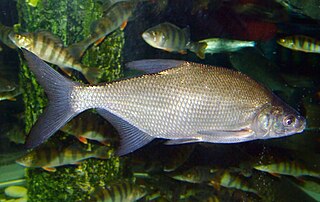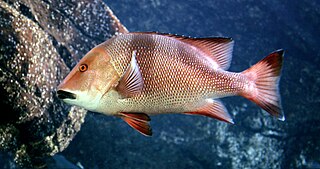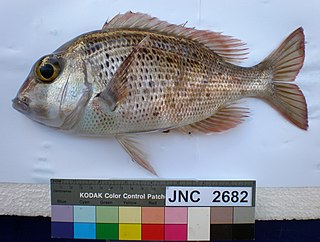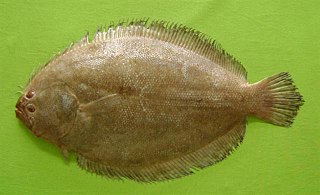
Sparidae is a family of ray-finned fishes belonging to the order Spariformes, the sea breams and porgies, although they were traditionally classified in the order Perciformes. They are found in shallow temperate and tropical waters around the world and are demersal carnivores.

The common bream, also known as the freshwater bream, bream, bronze bream, carp bream or sweaty bream, is a European species of freshwater fish in the family Cyprinidae. It is now considered to be the only species in the genus Abramis.
This glossary of ichthyology is a list of definitions of terms and concepts used in ichthyology, the study of fishes.

The silver drummer, also known as the buff bream, buffalo bream, buffs, common buffalo bream, drummer bream, Southern silver drummer or Sydney drummer, is a species of marine ray-finned fish, a sea chub from the family Kyphosidae. It is found in the southeastern Indian Ocean and the southwestern Pacific Ocean off Australia and New Zealand where it is found in shallow water near rocky reefs.

The European conger is a species of conger of the family Congridae. It is the heaviest eel in the world and native to the northeast Atlantic, including the Mediterranean Sea.

The vermilion snapper, the clubhead snapper, night snapper, Brian's red fish or beeliner is a species of marine ray-finned fish, a snapper belonging to the family Lutjanidae. It is native to the western Atlantic Ocean.

The longfin trevally, also known as the longfin kingfish, longfin cavalla or armed trevally, is a species of inshore marine fish in the jack family, Carangidae. The species is common in tropical to subtropical waters of the Indo-Pacific, ranging from South Africa in the west to Japan in the east, typically inhabiting inshore reefs and bays. The species is easily distinguished by its elongate dorsal and anal fin lobes and filamentous dorsal rays, as well as its scaleless breast. Longfin trevally are pelagic predators, taking a variety of small fish, cephalopods and crustaceans, and reach sexual maturity at around 21 cm. The species has a maximum known length of 57 cm and weight of 3.5 kg. The longfin trevally has a very complex taxonomic history which is closely intertwined with another currently valid species, Carangoides ciliarius, which may yet prove to be synonymous. Longfin trevally are of minor importance to fisheries throughout their range and are considered good table fish, and are occasionally taken by anglers.

Cephalopholis fulva, the coney or the butterfish, is a species of marine ray-finned fish, a grouper from the subfamily Epinephelinae which is in the family Serranidae which also includes the anthias and sea basses. It is found in the western Atlantic. It is associated with reefs and is a quarry species for commercial and recreational fisheries. It can be found in the aquarium trade.

Lutjanus sebae, also known as red emperor, emperor red snapper, emperor snapper, government bream, king snapper, queenfish or red kelp, is a species of marine ray-finned fish, a snapper belonging to the family Lutjanidae. It is native to the Indian Ocean and the western Pacific Ocean.
The painted swellshark is a little-known species of catshark, belonging to the family Scyliorhinidae, found in eastern Indonesia. This species reaches a maximum known length of 72 cm (28 in), and has a thick body with a short, broad and flattened head. It is dark gray with a variegated pattern of irregular darker and lighter blotches above, and lighter below with gray blotches and speckling on the snout. Like other swellsharks, it can inflate itself as a defensive measure.

Gymnocranius audleyi, the collared large-eye bream, collar bream, bastard bream, coral bream, iodine bream, pale-faced bream or sand snapper, is a species of marine ray-finned fish belonging to the family Lethrinidae, the emperors and emperor breams. This species is found in the Western Pacific Ocean.
Cancelloxus burrelli, the Slender platanna-klipfish, is a species of clinid found in subtropical waters of the Atlantic Ocean along the South African coast from the Orange River to Algoa Bay in South Africa. It can be found from the intertidal zone down to about 20 metres (66 ft). This species can reach a maximum length of 12 centimetres (4.7 in) TL.
Clinus brevicristatus, the Cape klipfish, is a species of clinid that occurs in subtropical waters of the Atlantic Ocean around South Africa where it prefers habitats with plentiful growth of seaweed. This species can reach a maximum length of 12 centimetres (4.7 in) TL.

Oplopomus oplopomus, commonly known as the spinecheek goby, is a species of goby native to the Indo-Pacific region. They can grow to a maximum length of 10 centimetres (3.9 in). They inhabit coral reefs.

Gymnocranius is a genus of marine ray-finned fishes belonging to the family Lethrinidae, the emperors and emperor breams. These fishes are found in the Indian Ocean and the western Pacific Ocean.

Polydactylus sextarius, the blackspot threadfin, is a species of marine ray-finned fish, a threadfin from the family Polynemidae which is native to the western Pacific and eastern Indian Oceans.

Nemipterus japonicus, the Japanese threadfin bream, is a species of marine ray-finned fish belonging to the family Nemipteridae, the threadfin and whiptail breams. This species is found in the Indo Pacific region and is an important food fish.

Pseudorhombus arsius, the largetooth flounder, is a species of left-eyed flatfish, that is the dark side with the eyes on the adult fish is the left side of the fish's body, from the family Paralichthyidae. As Rhombus polyspilos it was named as the type species of the genus Pseudorhombus. It is an Indo-Pacific species and is fished for by both recreational and commercial fisheries.
Placidochromis boops is a species of deep-water African cichlid endemic to the southern portion of Lake Malawi. This species can reach a length of up to 11.2 centimetres (4.4 in) SL.
Archolaemus luciae is a species of glass knifefish endemic to Brazil where it is found in the Rio Jari, the Rio Trombetas and the Rio Tapajós basins in the eastern Amazon. Also found in the Rio Araguari. This species reaches a length of 49.7 cm (19.6 in).

















